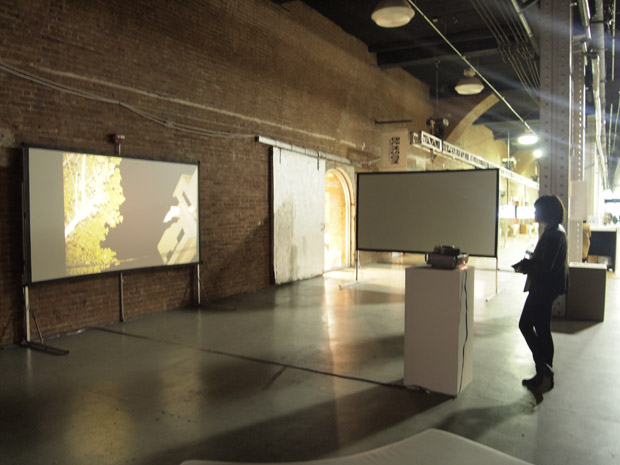Slowly but surely, galleries are reaching a breaking point with the art-fair circuit. With too many fairs to choose from, and now two competing fair seasons in New York, we’re hearing exhaustion touted as the lay of the land. Escape isn’t an option for most galleries. Instead of opting out, we’re seeing a rise in specialized fairs that provide an alternative to the white-walled booth model. This week alone, there’s Spring/Break, a curator-driven fair, the Independent, a boothless fair, and Moving Image, a fair devoted to video, new media, and all things moving image.
In its third year, Moving Image keeps getting better. The fair’s location, at the 27th street Tunnel Building, gives new media a proper exhibition space; the space consists entirely of a dark and quiet passageway lined with dozens of individual viewing stations and several installations. The fair allows dealers to leave their viewing stations unmanned.
“It’s time to change things up from the same old fair model,” Catlin Moore, director of Los Angeles’ Mark Moore Gallery, told us yesterday during Moving Image’s opening. With so many fairs across the country, Moore mentioned, “Our collectors are confused about where to go.” The gallery has turned its attention to fairs outside of Los Angeles, and with Moving Image, they wanted to trumpet their roster’s five video artists; it’s harder to do that can’t be done at just any brightly-lit, noisy fair. Those are difficult conditions to achieve at fairs like Pulse or the Armory Show, where Mark Moore Gallery has previously shown.
That sentiment of doing justice to the medium was reiterated by many dealers we spoke with throughout the fair. “There’s no art-fair noise,” Postmasters’s Magda Sawon told us, adding that that’s necessary because, overall, “Video is a serious medium.”
The fair does, indeed, have an air of seriousness. Walking through the fair, it’s dark, and a little spooky, making it unlike any other fair in town. Outside of the occasional hums and grunts emanating from some video installations, the space is quiet as a church. No wonder, then, that it feels so much like a religious procession to walk from one end of the tunnel to the other.
That seriousness lends itself well to the fair’s audience. More than collectors, whose taste can seem whirlygig, the fair intends to cultivate curators as its base. “Museums are the audience for video,” Interstate Projects Director Tom Weinrich mentioned, when asked about who’s visiting the fair.
Knowing its base, Moving Image has consistently done well well at featuring a wide spectrum of historical video art from the likes of P.P.O.W. and the Video Data Bank. The Video Data Bank’s selection this year is a gem: Two Faces (1972), a six-minute-long video of Hermine Freed playing with, hiding from, and occasionally kissing her reflection, invites comparisons ranging from Francesca Woodman to a more contemporary, iPhone self-portrait aesthetic. This year, too, Moving Image has deepened its ties to the museum world by inviting El Museo del Barrio to curate a selection of works by Puerto Rico-born Edin Vélez.
More than the attraction of curators, or the proper place of video, there’s another, simpler reason why dealers like to participate in Moving Image: it’s laid back. In a time of too many fairs, it’s easy to stretch yourself thin. Dealers noted that they appreciate not needing to be on-site at all times, especially when they’re participating in more than one fair this week alone.
In a time of too many fairs, small touches like this that can distinguish each fair from one another. Dealers, it seems, would be prefer to choose fairs that play up their interests, do justice to their artists, and, ultimately, leave wanting to come back again.



Comments on this entry are closed.